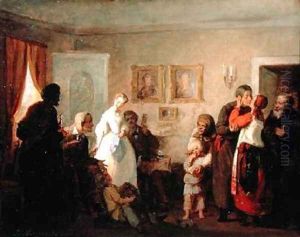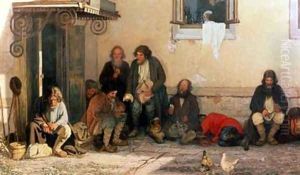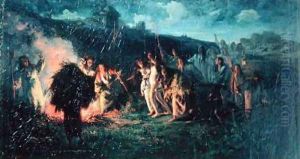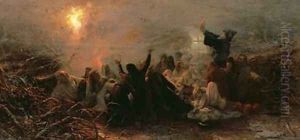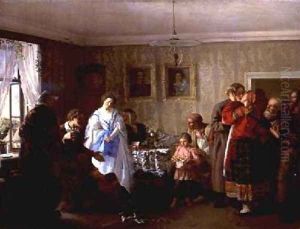Grigori Grigorievich Mjasoedov Paintings
Grigori Grigorievich Mjasoedov was a distinguished Russian painter, born on April 19, 1834, in Tula Province, Russia. He emerged as a significant figure in the Russian art scene of the 19th century, known for his realistic portrayals of peasant life, landscapes, and historical subjects. Mjasoedov's artistic journey began at the Moscow School of Painting, Sculpture and Architecture, and he later honed his skills at the Imperial Academy of Arts in Saint Petersburg, where he was recognized for his exceptional talent.
Throughout his career, Mjasoedov was deeply influenced by the critical social and cultural changes occurring in Russia during his lifetime. He was a founding member of the Peredvizhniki (Wanderers or Itinerants), a cooperative of realist artists who sought to break away from the academic restrictions of the time, aiming to make art more accessible to the public. This group organized traveling exhibitions, bringing art to various cities across Russia, thus democratizing art appreciation and focusing on themes of social and political relevance.
Mjasoedov's work is characterized by its meticulous attention to detail, vivid portrayal of the Russian countryside, and a profound empathy for the peasantry. One of his most celebrated works, 'The Zemstvo Dines' (1872), exemplifies his ability to capture the social dynamics and rural life of Russia with honesty and depth. This painting, among others, showcases his critical view of societal inequalities and his commitment to social realism.
Despite his success, Mjasoedov's later years were marked by a gradual decline in popularity, as the art world's focus shifted with the advent of modernist movements. However, his contributions to Russian art did not go unrecognized. He was awarded several medals and honors, including the title of Academician by the Imperial Academy of Arts for his achievements in painting.
Grigori Grigorievich Mjasoedov passed away on March 21, 1911, in Saint Petersburg, leaving behind a rich legacy that continues to influence Russian art. His works are preserved in major museums across Russia, including the Tretyakov Gallery in Moscow and the Russian Museum in Saint Petersburg, serving as enduring testimonies to his artistic prowess and his insightful representation of 19th-century Russian society.
